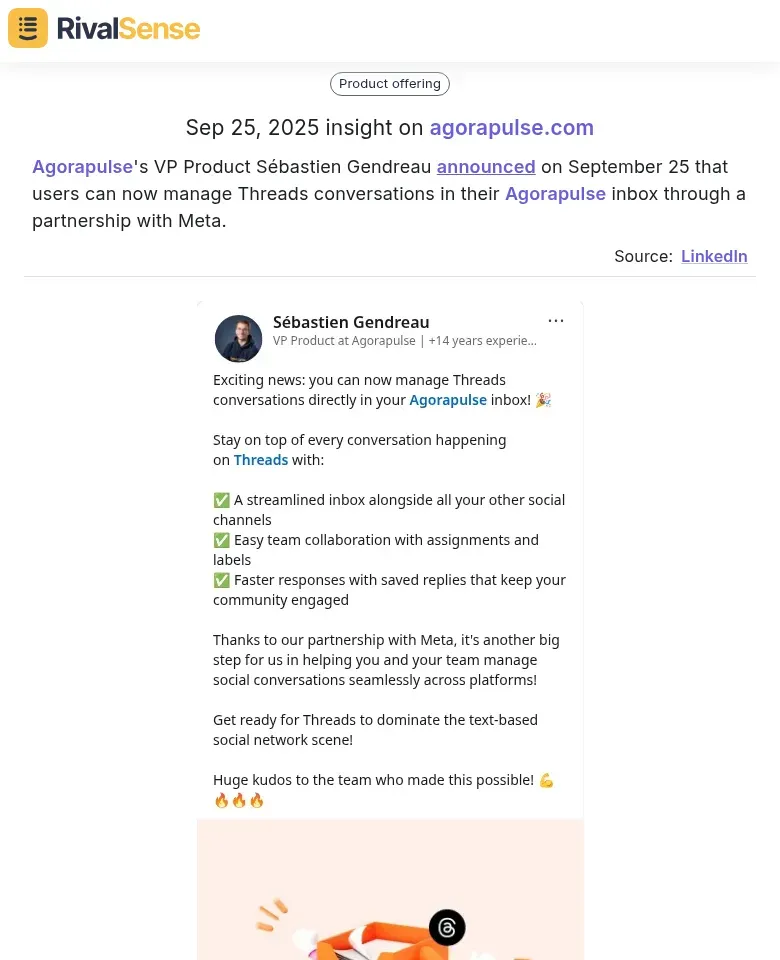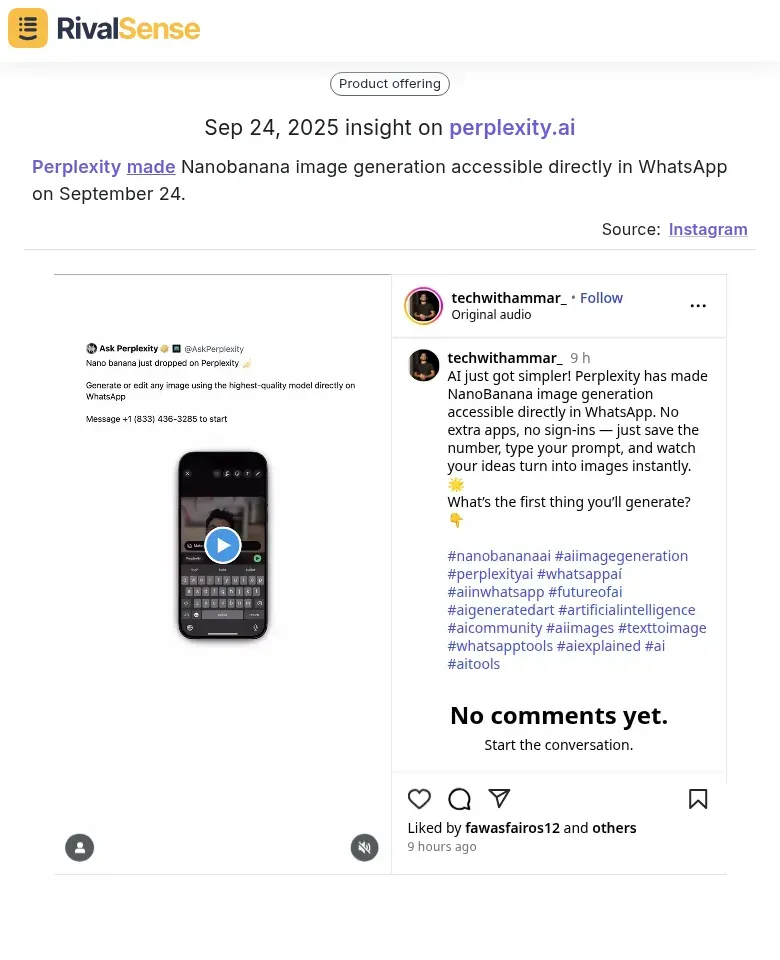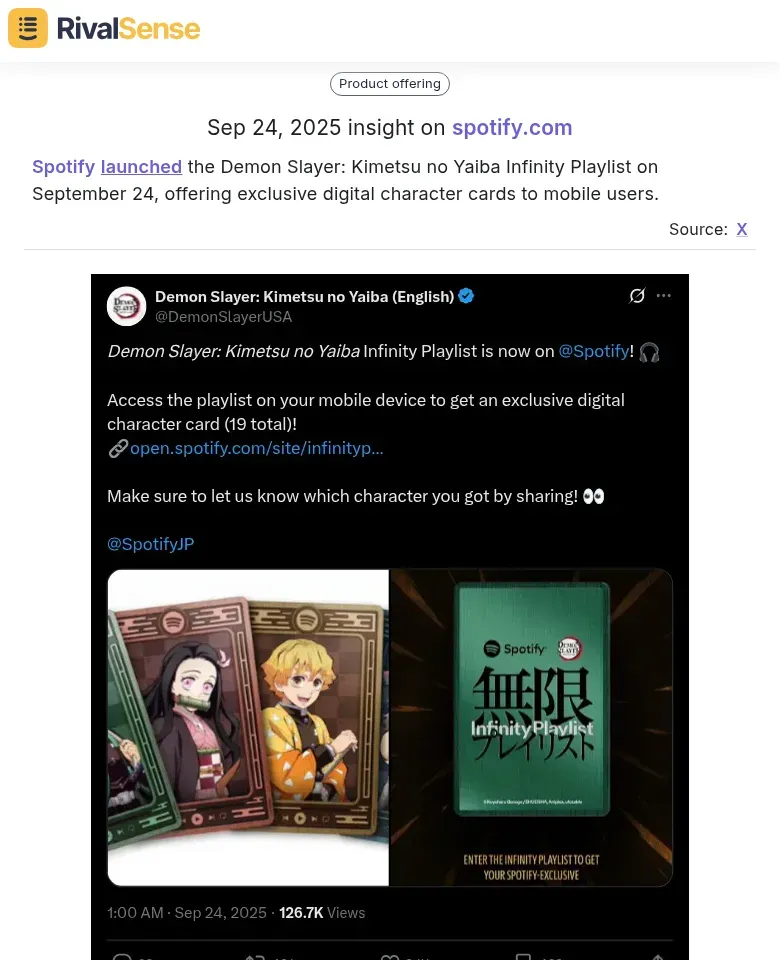Mastering Competitor Pricing Models: A Strategic Guide for B2B Leaders
Table of Contents
- What Is Competitive Pricing?
- Key Strategies for Competitive Pricing
- Differentiating Your Product for Premium Pricing
- Exploring Loss Leader Strategies
- Leveraging Price Matching Offers
- The Impact of Competitor Innovations on Pricing
- Practical Steps to Analyze Competitor Pricing Models
- How RivalSense Enhances Your Pricing Strategy
- The Bottom Line
What Is Competitive Pricing?
Competitive pricing is a strategic approach where businesses set prices based on their market position relative to competitors. This method is crucial once a product matures and faces numerous substitutes, as it helps align pricing with business objectives like market penetration or profit maximization. By pricing above, at, or below competitors, companies can target different customer segments—from premium buyers seeking quality to bargain hunters attracted by low costs. For instance, a SaaS company might undercut a rival's subscription fee to gain market share, while another could charge more by highlighting superior customer support. The key is to continuously monitor the competitive landscape to stay agile.
Key Takeaways:
- Competitive pricing involves strategic price points that reflect market dynamics and competitor actions.
- Options include pricing below, at, or above competitors, often using tactics like loss leaders or premium pricing.
- Success depends on understanding competitor behavior and adapting quickly—something tools like RivalSense automate by tracking pricing changes across 80+ sources, delivering insights in weekly reports.
Key Strategies for Competitive Pricing
Businesses must carefully select their pricing approach to stay competitive in dynamic markets. Understanding these strategies is key to positioning your product effectively and responding to market shifts. Companies can choose from three primary pricing strategies relative to competitors:
-
💰 Pricing Below the Competition: This approach, often part of a loss leader strategy, involves setting prices lower than rivals to attract customers. The goal is to drive traffic and encourage purchases of higher-margin products. For example, a cloud storage provider might offer a basic plan at a loss, hoping users upgrade to premium tiers. However, this requires careful monitoring to avoid sustained losses.
-
⚖️ Pricing at the Competition: Setting prices equal to competitors is common in saturated markets. Here, differentiation comes through marketing, customer service, or unique features. A B2B software company might match a competitor's price but emphasize faster implementation or better integration options.
-
🚀 Pricing Above the Competition: Premium pricing demands added value, such as innovation, quality, or exclusive services. Apple exemplifies this by charging more for iPhones due to perceived uniqueness. To justify higher prices, businesses must continuously innovate and communicate their value proposition.
Practical Tip: Regularly audit competitor pricing using this checklist:
- [ ] Identify key competitors and their pricing tiers.
- [ ] Monitor for discounts, promotions, or seasonal changes.
- [ ] Analyze customer reviews to see if price complaints affect loyalty.
- [ ] Use competitive intelligence tools like RivalSense to automate this process, ensuring you never miss a pricing update.
Differentiating Your Product for Premium Pricing
Charging above market rates requires a clear value proposition that sets your product apart. Differentiation is essential to justify higher prices and attract discerning customers. To charge premium prices, your product must stand out through various means:
- Enhanced Features: Add functionalities competitors lack, like AI-driven analytics in a marketing platform.
- Superior Quality: Focus on reliability, as seen with enterprise software that offers 99.9% uptime guarantees.
- Brand Perception: Build a reputation for excellence through thought leadership and customer testimonials.
For example, a project management tool might justify a higher price by integrating advanced collaboration features that save time. Conduct A/B testing to gauge customer willingness to pay, and use competitive tracking to ensure your differentiators remain unique. RivalSense helps here by alerting you to competitor product launches, so you can adjust your strategy before markets shift.
Exploring Loss Leader Strategies
A loss leader strategy involves selling products below cost to attract customers who may purchase more profitable items later. This approach can be highly effective for customer acquisition and retention in competitive environments. In B2B contexts, this could mean offering a free trial or discounted entry-level service to hook clients into premium packages. For instance, a CRM provider might give away basic features, aiming to upsell advanced analytics.
Considerations:
- Ensure the loss is temporary and calculable.
- Track conversion rates to measure effectiveness.
- Be aware of legal restrictions, like minimum advertised prices set by manufacturers.
Hint: Use loss leaders during slow seasons or to counter new competitor entries. With RivalSense, you can monitor when competitors run similar promotions, allowing you to time your strategies for maximum impact.
Leveraging Price Matching Offers
Price matching allows businesses to respond swiftly to competitor price changes without permanently altering their pricing structure. This tactic helps maintain customer loyalty during intense competitive periods, such as holiday sales or market disruptions. For example, when Amazon slashed prices for Black Friday, retailers like Walmart offered matches to retain customers.
Steps to Implement Price Matching:
- Define clear terms (e.g., match only verified competitor ads).
- Train staff to handle requests efficiently.
- Use it sparingly to avoid eroding brand value.
This approach requires real-time competitor data—a gap that RivalSense fills by providing timely alerts on pricing changes, so you can act swiftly.
The Impact of Competitor Innovations on Pricing
Competitor activities beyond pricing, such as product launches and partnerships, can significantly influence your pricing strategy. Monitoring these innovations provides early insights into market trends and potential pricing shifts. For instance, a new feature integration might allow a competitor to justify a price increase, affecting your positioning.
Agorapulse's Partnership with Meta

Agorapulse's VP Product Sébastien Gendreau announced on September 25 that users can now manage Threads conversations in their Agorapulse inbox through a partnership with Meta. Why this insight is valuable: Tracking partnerships can reveal how competitors enhance their offerings, potentially enabling them to command higher prices. By monitoring such moves, you can anticipate pricing changes and adjust your strategy to emphasize your unique value.
Perplexity's Feature Accessibility

Perplexity made Nanobanana image generation accessible directly in WhatsApp on September 24. Why this insight is valuable: Product feature expansions signal competitive differentiation, which often precedes pricing adjustments. Understanding these innovations helps you decide whether to match, undercut, or highlight your own advancements to stay competitive.
Spotify's Exclusive Content Launch

Spotify launched the Demon Slayer: Kimetsu no Yaiba Infinity Playlist on September 24, offering exclusive digital character cards to mobile users. Why this insight is valuable: Exclusive content or features can support premium pricing strategies by adding perceived value. In B2B, similar exclusive partnerships or launches can be leveraged to justify higher price points, making it crucial to track these developments.
Practical Steps to Analyze Competitor Pricing Models
Building a robust pricing strategy requires a systematic approach to competitor analysis. Regular assessment helps you stay ahead of market changes and make informed decisions. Follow this actionable checklist to analyze competitor pricing effectively:
- Identify Competitors: List direct and indirect rivals using market research tools.
- Gather Data: Collect pricing information from websites, social media, and industry reports. Manually, this is time-consuming; automate with RivalSense for comprehensive coverage.
- Analyze Patterns: Look for trends like frequency of changes, discount strategies, or bundle offers.
- Assess Value Propositions: Compare what competitors offer at each price point—are there hidden costs or superior features?
- Test and Iterate: Run pilot pricing experiments and measure customer response.
- Monitor Continuously: Pricing is dynamic; set up alerts for changes to stay agile.
Example: A B2B analytics firm discovered via RivalSense that a competitor lowered prices quarterly. They preempted this by introducing a loyalty discount, retaining customers proactively.
How RivalSense Enhances Your Pricing Strategy
Manual competitor tracking is inefficient and prone to errors, but automation can transform your pricing approach. RivalSense provides real-time insights that enable proactive decision-making. It monitors 80+ sources—including company websites, social media, and registries—for pricing updates, product launches, partnerships, and more. Subscribers receive weekly reports highlighting key changes, allowing you to respond swiftly to competitor moves.
For instance, if a competitor announces a price hike or a new feature, RivalSense alerts you, enabling you to evaluate whether to match, undercut, or emphasize your value. This tool helps you focus on strategy rather than data collection, giving B2B leaders a competitive edge.
The Bottom Line
Competitive pricing is a dynamic strategy that requires continuous monitoring and adaptation. By leveraging tactics like premium pricing, loss leaders, and price matching, you can optimize your market position. Remember, timely intelligence is the foundation of effective pricing—consider integrating tools like RivalSense to streamline competitor tracking.
Ready to take control of your pricing strategy? Try RivalSense for free at https://rivalsense.co/ and get your first competitor report today to stay ahead of the competition.
📚 Read more
👉 5 Key Account Management Mistakes Influencer Platforms Must Avoid
👉 How XTX's TernFS Open Source Move Revealed ML Strategy Gaps
👉 Advanced API Tactics for Key Account Competitor Intelligence
👉 Beginner's Guide to Printing Industry Competitive Benchmarking
👉 Competitor Media & Content Insights Checklist for Strategic Account Tracking
